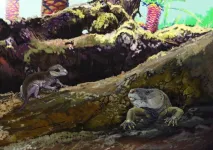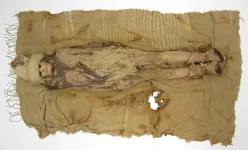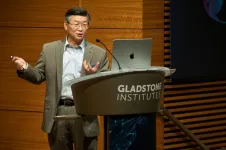(Press-News.org) A landmark study led by UCLA Health has begun to unravel one of the fundamental mysteries in neuroscience – how the human brain encodes and makes sense of the flow of time and experiences.
The study, published in the journal Nature, directly recorded the activity of individual neurons in humans and found specific types of brain cells fired in a way that mostly mirrored the order and structure of a person’s experience. They found the brain retains these unique firing patterns after the experience is concluded and can rapidly replay them while at rest. Furthermore, the brain is also able to utilize these learned patterns to ready itself for future stimuli following that experience. These findings provide the first empirical evidence regarding how specific brain cells integrate “what” and “when” information to extract and retain representations of experiences through time.
The study’s senior author, Dr. Itzhak Fried, said the results could serve in the development of neuro-prosthetic devices to enhance memory and other cognitive functions as well as have implications in artificial intelligence’s understanding of cognition in the human brain.
“Recognizing patterns from experiences over time is crucial for the human brain to form memory, predict potential future outcomes and guide behaviors,” said Fried, director of epilepsy surgery at UCLA Health and professor of neurosurgery, psychiatry and biobehavioral sciences at the David Geffen School of Medicine at UCLA. “But how this process is carried out in the brain at the cellular level had remained unknown – until now.”
Previous research, including by Dr. Fried, used brain recordings and neuroimaging to understand how the brain processes spatial navigation, showing in animal and human models that two regions of the brain – the hippocampus and the entorhinal cortex – played key roles. The two brain regions, both important in memory functions, work to interact to create a “cognitive map." The hippocampal neurons act as "place cells" that show when an animal is at a specific location, similar to an 'X' on a map, while the entorhinal neurons act as "grid cells" to provide a metric of spatial distance. These cells found first in rodents were later found in humans by Fried’s group.
Further studies have found similar neural actions work to represent non-spatial experiences such as time, sound frequency and characteristics of objects. A seminal finding by Fried and his colleagues was that of “concept cells” in human hippocampus and entorhinal cortex that responds to particular individuals, places or distinct objects and appear to be fundamental to our ability for memory.
To examine the brain processing of events in time, the UCLA study recruited 17 participants with intractable epilepsy who had been previously had depth electrodes implanted in their brains for clinical treatment.
Researchers recorded the neural activity of the participants as they underwent a complex procedure that involved behavioral tasks, pattern recognition and image sequencing.
Participants first underwent an initial screening section during which approximately 120 images of people, animals, objects and landmarks were repeatedly shown to them on a computer over about 40 minutes. The participants were instructed to perform various tasks such as determining whether the image showed a person or not. The images, of things like famous actors, musicians and places, were selected partly based on each participant’s preferences.
Following this, the participants underwent a three-phase experiment in which they would perform behavioral tasks in response to images that were arbitrarily displayed on different locations of a pyramid-shaped graph. Six images were selected for each participant.
In the first phase, images were displayed in a pseudo-random order. The next phase had the order of images determined by the location on the pyramid graph. The final phase was identical to the first phase. While watching these images, the participants were asked to perform various behavioral tasks that were unrelated to the positioning of the images on the pyramid graph. These tasks included determining whether the image showed a male or female or whether a given image was mirrored compared to the previous phase.
In their analyses, Fried and his colleagues found the hippocampal-entorhinal neurons gradually began to modify and closely align their activity to the sequencing of images on the pyramid graphs. These patterns were formed naturally and without direct instruction to the participants, according to Fried. Additionally, the neuronal patterns reflected the probability of upcoming stimuli and retained the encoded patterns even after the task was completed.
Lead author of the study was Pawel Tacikowski with co-authors Guldamla Kalendar and Davide Ciliberti.
“This study shows us for the first time how the brain uses analogous mechanisms to represent what are seemingly very different types of information: space and time,” Fried said. “We have demonstrated at the neuronal level how these representations of object trajectories in time are incorporated by the human hippocampal-entorhinal system.”
Article: Human hippocampal and entorhinal neurons encode the temporal structure of experience, Tacikowski et al., Nature, 2024, https://doi.org/10.1038/s41586-024-07973-1
END
Encoding human experience: Study reveals how brain cells compute the flow of time
UCLA researchers say findings could have implications for improving memory, cognitive functions and artificial intelligence
2024-09-25
ELSE PRESS RELEASES FROM THIS DATE:
New study: Deep-sea discovery shines light on life in the twilight zone
2024-09-25
TAMPA, Fla. (Sept. 23, 2024) – The ocean’s twilight zone is deep, dark, and — according to new research — iron deficient.
No sunlight reaches this region 200 to 1,000 meters below the sea surface, where levels of iron, a key micronutrient, are so low that the growth of bacteria is restricted. To compensate, these bacteria produce molecules called siderophores, which help the bacteria scavenge trace amounts of iron from the surrounding seawater.
The paper detailing these unexpected findings from the Pacific Ocean will publish on Wednesday, Sept. 25, at 11 a.m. ET (4 p.m. London Time) in Nature, and will be viewable at that time at this link. The ...
Brazilian fossils reveal jaw-dropping discovery in mammal evolution
2024-09-25
These fossils, belonging to the mammal-precursor species Brasilodon quadrangularis and Riograndia guaibensis, offer critical insights into the development of the mammalian jaw and middle ear, revealing evolutionary experiments that occurred millions of years earlier than previously thought.
Mammals stand out among vertebrates for their distinct jaw structure and the presence of three middle ear bones. This transition from earlier vertebrates, which had a single middle ear bone, has long fascinated scientists. The new study explores how mammal ancestors, known as cynodonts, evolved these features ...
Now we know why children with Down’s syndrome have higher risk of Leukemia
2024-09-25
People with Down’s syndrome face a higher risk of developing Leukemia. Now researchers from the University of Copenhagen and Stanford University explain why, by identifying specific changes in blood cells of people with Down’s syndrome.
In the world, one out of 700 children are born with Down’s syndrome. A syndrome, where the child has an extra copy of chromosome 21, resulting in 47 chromosomes instead of 46. This typically results in characteristic physical features and some level of learning disability.
But newborns with Downs syndrome also tend to have an elevated number of red blood ...
Emerging SARS-CoV-2 resistance after antiviral treatment
2024-09-25
About The Study: Treatment-emergent nirmatrelvir resistance mutations were commonly detected, especially in individuals who were immunosuppressed in this cohort study of 156 participants. However, these mutations were generally present at low frequencies and were transient in nature, suggesting a low risk for the spread of nirmatrelvir resistance in the community with the current variants and drug usage patterns.
Corresponding Author: To contact the corresponding author, Jonathan Z. Li, MD, MMsc, email jli@bwh.harvard.edu.
To access the embargoed study: Visit ...
Semaglutide and opioid overdose risk in patients with type 2 diabetes and opioid use disorder
2024-09-25
About The Study: In this study, semaglutide was associated with reduced opioid overdose risk in patients with comorbid type 2 diabetes and opioid use disorder, suggesting its potential therapeutic value for preventing overdoses. The results need validation from other data resources and study populations. Further research is warranted to investigate the underlying mechanisms and randomized clinical trials are necessary to corroborate the clinical effects on opioid use disorder.
Corresponding Authors: To contact the corresponding authors, email Rong Xu, PhD, (rxx@case.edu) ...
Bronze age lactobacillus genomes clarify kefir history
2024-09-25
Food fermentation is the oldest production practice using microorganisms in human history. Milk fermentation, for example, can be traced back to 6000–4000 BC in India, and Mediterranean populations produced and consumed cheese as early as 7000 before present (BP).
Despite the long history of human consumption of fermented products, though, little has been known about the history of the use of fermentative microorganisms and the history of related cultural transmission. In particular, the evolutionary trajectories, especially functional adaptation, of these ...
Higher doses of buprenorphine may improve treatment outcomes for people with opioid use disorder
2024-09-25
Adults with opioid use disorder who receive a higher daily dose of the opioid addiction treatment medication buprenorphine may have a lower risk of subsequent emergency department visits or use of inpatient services related to behavioral health (such as for mental health and substance use disorders) than adults receiving the recommended dose, according to an analysis funded by the National Institutes of Health (NIH). These findings suggest that higher buprenorphine doses could be more effective in managing opioid use disorder, which may be particularly relevant for improving treatment for those who use fentanyl, a major ...
One in two El Niño events could be extreme by mid-century
2024-09-25
With the climate pattern known as El Niño in full force from mid-2023 to mid-2024, global temperatures broke records for 12 months in a row. As one of the strongest El Niño events on record, it was likely the main culprit of unprecedented heat, floods and droughts worldwide.
In a new study published Sep. 25 in the journal Nature, a University of Colorado Boulder climate scientist and collaborators reveal that the planet could see more frequent extreme El Niño events by 2050 if greenhouse gas emissions continue to increase.
“It’s ...
Bacterial ‘flipping’ allows genes to assume different forms
2024-09-25
Imagine being one cartwheel away from changing your appearance. One flip, and your brunette locks are platinum blond. That’s not too far from what happens in some prokaryotes, or single-cell organisms, such as bacteria, that undergo something called inversions.
A study led by scientists at Stanford Medicine has shown that inversions, which cause a physical flip of a segment of DNA and change an organism’s genetic identity, can occur within a single gene, challenging a central dogma of biology — that one gene can code ...
Gladstone presents inaugural Sobrato prize in neuroscience to Yadong Huang, a pioneer of Alzheimer’s research
2024-09-25
Gladstone Institutes has established a new scientific award, the Sobrato Prize in Neuroscience, to advance breakthroughs in brain research with high potential for patient impact—and announced it will present the inaugural prize to Yadong Huang, MD, PhD, a trailblazer in Alzheimer’s research.
In his nearly three decades at Gladstone, Huang has led a series of pioneering studies on the genetic underpinnings of Alzheimer’s disease, with discoveries that have opened multiple new avenues for drug development. He ...
LAST 30 PRESS RELEASES:
Numbers in our sights affect how we perceive space
SIMJ announces global collaborative book project in commemoration of its 75th anniversary
Air pollution exposure and birth weight
Obstructive sleep apnea risk and mental health conditions among older adults
How talking slows eye movements behind the wheel
The Ceramic Society of Japan’s Oxoate Ceramics Research Association launches new international book project
Heart-brain connection: international study reveals the role of the vagus nerve in keeping the heart young
Researchers identify Rb1 as a predictive biomarker for a new therapeutic strategy in some breast cancers
Survey reveals ethical gaps slowing AI adoption in pediatric surgery
Stimulant ADHD medications work differently than thought
AI overestimates how smart people are, according to HSE economists
HSE researchers create genome-wide map of quadruplexes
Scientists boost cell "powerhouses" to burn more calories
Automatic label checking: The missing step in making reliable medical AI
Low daily alcohol intake linked to 50% heightened mouth cancer risk in India
American Meteorological Society announces Rick Spinrad as 2026 President-Elect
Biomass-based carbon capture spotlighted in newly released global climate webinar recording
Illuminating invisible nano pollutants: advanced bioimaging tracks the full journey of emerging nanoscale contaminants in living systems
How does age affect recovery from spinal cord injury?
Novel AI tool offers prognosis for patients with head and neck cancer
Fathers’ microplastic exposure tied to their children’s metabolic problems
Research validates laboratory model for studying high-grade serous ovarian cancer
SIR 2026 delivers transformative breakthroughs in minimally invasive medicine to improve patient care
Stem Cell Reports most downloaded papers of 2025 highlight the breadth and impact of stem cell research
Oxford-led study estimates NHS spends around 3% of its primary and secondary care budget on the health impacts of heat and cold in England
A researcher’s long quest leads to a smart composite breakthrough
Urban wild bees act as “microbial sensors” of city health.
New study finds where you live affects recovery after a hip fracture
Forecasting the impact of fully automated vehicle adoption on US road traffic injuries
Alcohol-related hospitalizations from 2016 to 2022
[Press-News.org] Encoding human experience: Study reveals how brain cells compute the flow of timeUCLA researchers say findings could have implications for improving memory, cognitive functions and artificial intelligence



